Does Swinging arm design for a twin-shock really make a difference?
We take a look at the ones used on the Otter family...And others...

Faber Mk 3 Frame and swinging arm...
I thought I would do a page on the difference between, and what makes a good swinging arm for your Otter, and other makes of twinshock machines.
The Harry Foster and the later Faber Mk1 Otter swinging –arms differ very little except for the Faber one being nearly an inch wider.
These were basically fabricated copies of the old BSA lugged design and of coarse the Triumph TR20 Cub arm has used in the making of the original Scott Ellis bike.
But Howard at Faber later changed the design on the later Faber Otter frames to be of only three components, and even later, nylon through bushes.
Did doing this change the character of the ride? Well a lot think so. And not for the better. But why? Was it the fact that doing away with the old BSA copy configuration made the swinging arm twist more? Or was it down to the lighter tubing used?
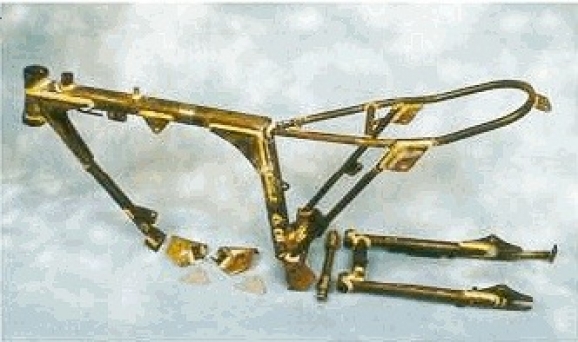
Faber Mk1 frame with the old layout...
~~~~~~~
The old school swinging arms were made of very heavy poor grade tubing sweated into the appropriate castings. And not actually designed if that was the right word, for any off road motorcycling.
But also the early-fabricated arms were made of heavy gauge steel tubing, and the example I have from a CoTTon trials frame, was I think made by an agricultural machinery manufacturing company…
Well you could plough a field with it and it would not bend.
A swinging arm is actually un-sprung weight, so does it really matter how heavy the item is, it just adds to the overall weight of the machine.
CoTTon Swinging arm Photo...

~~~~~~~
This is the CoTTon swinging arm, Circa 1967..
This arm is twice as heavy as the rest of the arms here, the 12 or even 10 gauge tubing was only mild steel and was welded with and Arc welder (Stick), and I was told by someone that they were in-fact made by a local to Gloucester agricultural machinery company, and I know there were two or three in the area, but I don't know how true this was...
Look at the design though, this has the "boxing in " effect at the front with the pivot tube bushes being carried in short tubes in front of the main brace tube, and again the engine mounting was run through with the pivot bolt...
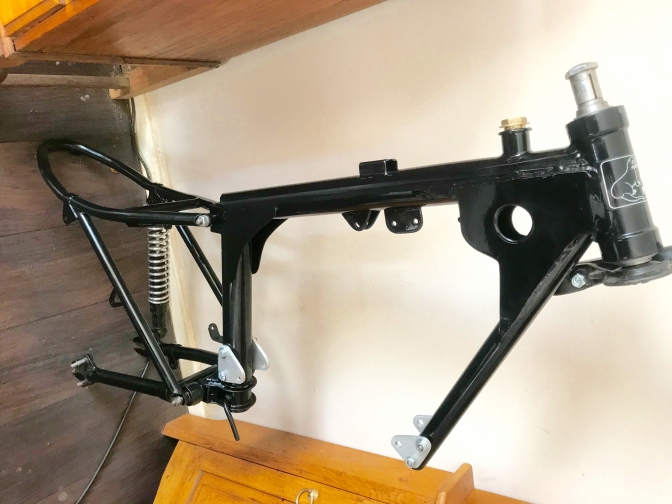
This is my Foster Otter Frame using a Triumph Cub F 4550 swinging arm and Mountain Cub subframe...
~~~~~~~
Twisting well that is probably the crux of the matter, do we want a bit of movement in an arm or not. A good example of swinging arms twisting more than they should is the Fraser Honda.
Built out of rectangular ERW tubing and a single pivot tube you would think it would be all right? But this arm just well, bent, and many a time I have seen a guy with a huge length of branch wood out of a hedge trying to prize the wheel back into an upright position.
So what twisted it? The shear power from the engine, or bad design?
So you see there is a lot of questions, so how do we answer them?
I will get back to the Otter family swinging arms, as I basically know about all of them so makes it easier to try and find and explain the difference between these.
Fraser Honda Photo...
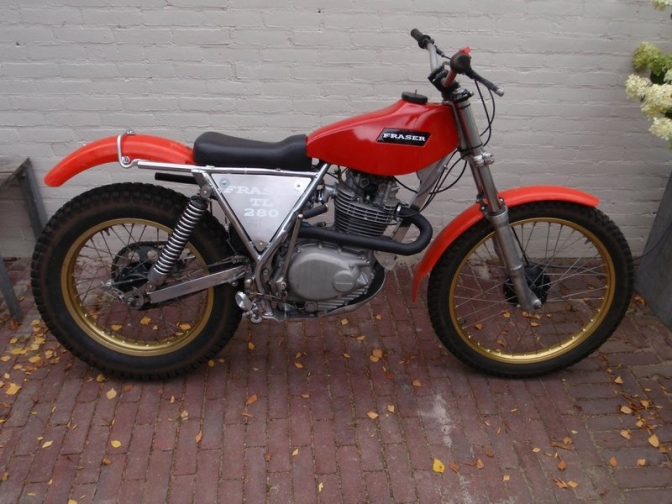
This Fraser arm design just twisted...without explination...
I will start with a quote or two, which I remember. I wont embarrass the ones that worded these but they are in these pages. “ Well the earlier bikes handled and felt better than the later ones, but I can’t put my finger on it”.
Well this was about the Faber Otter frame.
The other was, “Well the Foster Otter frames always handled a lot better than the later copies”.
As I said the only real difference between the first Faber Otter frame and the earlier Foster Otter, was the width of the arm, the Faber is almost an inch wider than the Foster as you can see. Below.
Photos…

This is the Foster swinging arm jig, yes it is crude, and when I first saw it I thought it was just a bit of scrap... But if you look at the photo below you will see that the arm fits perfectly, and there is a fixture for locating every bracket on the arm including the side stand spring peg...

The tubing used on this Foster Otter arm is slightly smaller section than the Faber arm the Foster is 1,1/8" and the Faber is 1,1/4"...
~~~~~~~
And you will say, what about the frame though?
Well don’t forget that I have the original Foster jig and also my own jig set up from a Faber Mk1 frame.
And I can tell you the angles are the same, it was not until later on the Mk 1 1/2 as I call it, that Howard steepened the steering head angle a tad.
So does the width of the arm make a difference?
Across the wheel plates at the back the average between all of them is seven inches, give or take a thou or four. The difference between the Foster frames at the pivot end is an inch well slightly more, Foster
7 inches, Faber just over 8 inches.
And the Mills frame arms are again seven inches.
And they are said to handle better than any?
We will get to the Mills arms later.
I can’t see as the width at the pivot makes a lot of difference only to make the bike a bit slimmer, as most frames are braced at this point by the suspension unit down struts...
I think it is the extra cross brace just behind the pivot on the swinging arm that is the key.
In other words this extra cross member along with the pivot bolt running through the two tubes with the silent block mounting bushes or even nylon, iGUS iglidur, or needle rollers, sort of boxes in this area and makes it more rigid at the front of the arm. This goes one further on the Mills frames as a centre box also doubles as a back engine mounting, attaching that to the swinging arm as well.
So is this the key...
An example is the Mini-Otter frames.
As you probably know these are based around the Mike Mills frame concept with the addition of the Otter top and seat tubes.
The Mk1 Mini-Otter frame had been tested in the IOM for two-three years...
And I had gone back to the original Mills layout for the swinging arm, as I was using the silent-block bushes in the Foster Otter arms and thought it sensible to also use them again on the Mini-Otter frame.
So number two three and four Mini-Otter swinging arms, were made to this pattern… and now.. five six seven...

This is the arm for the Mini-Otter I have gone back too...
with the pivot back into forward facing tubes.
I may later connect the bottom rear engine mounting plates to this pivot bolt to see if it makes any difference.
~~~~~~~

This is the arm that was fitted to the number one Mini-Otter bike, with the pivot bolt running on Nylon bushes...
You can see that I used oval tube for the blades on these arms.
~~~~~~~
Brian Bedford thought he was loosing out by not having one on the first bike, so I built another, and he came over to have it fitted. Now I had ridden the first bike quite a bit when I first built it, and thought how well it handled. But after fitting the new arm and just riding up to the end of the lane and back the bike felt, well, different, and more positive and not a lot had been changed on the bike except for changing the fork oil to new.
So was it all in my head, or did that arm make a difference by just having the front end squared off as I call it…
To Be sure I am going to fit the first swinging arm back into the number six bike. (In build now,) to compare it with bike number two and five which have the same engines and exactly the same frames and set up…
I will also pop into one bike just to test the Mills swinging arm to see if that makes a difference…
But we just need to get this “Lockdown” over before we can do anything…
Well, I can build up five and six…and even now 2023 seven..
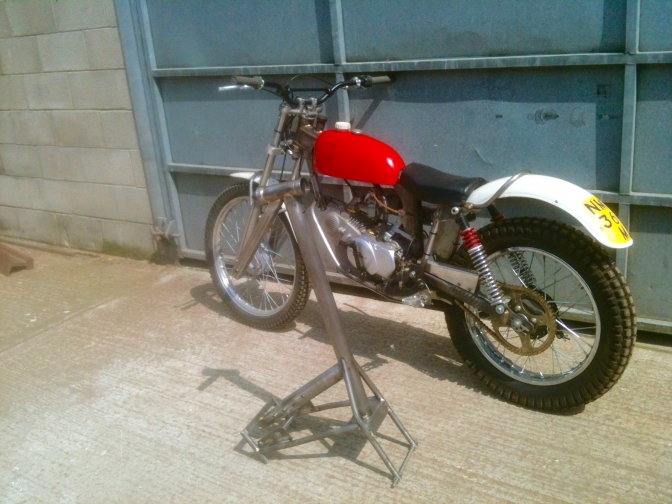
This is Mini-Otter Two and frame number four...
Built to Mike Mills frame specification...
~~~~~~~
We will carry on with this theory later...
But I can hear some of you saying, it is not the swinging arm that makes a bike ride better or worse, or feel more positive or not.
It is down to the rear twin-shock suspension units fitted, that is what makes the difference!
Is it ?
Suspension is a totally different story, and we will cover that aspect of how bikes feel and grip later,on this page and in depth...
A lot of people say the biggest advantage to how a bike rides and feels is not the swinging arm at all, but the stiffness of the frame top and seat tubes. Well we dont have a problem with that with the Otter frames as being of 2" section the tubing is rigid in all planes.
It is when smaller section tube is used that this may become a problem with frame twist, and whip, and don't forget from the early fifties most trials bike frames were just modified road going units taken from the production line, and then modified to what was known then as trials bike specification, this usally meant adding a few gusset plates to the frame or strengthening the sub frames, and finding more rear tyre clearance. This was also governed in most cases by the use of the same cast lugs used in the manufacture of the road bikes and these dictated the angles used.
For an Otter frame I feel that the smallest section you can use for these two, or even one bent Backbone section of tube is 1.3/4" the same as the Faber Mk3 Otter, and the original Ariel HT frame where the "big tube" concept started in the first place. We will get into the use of square section tube later...
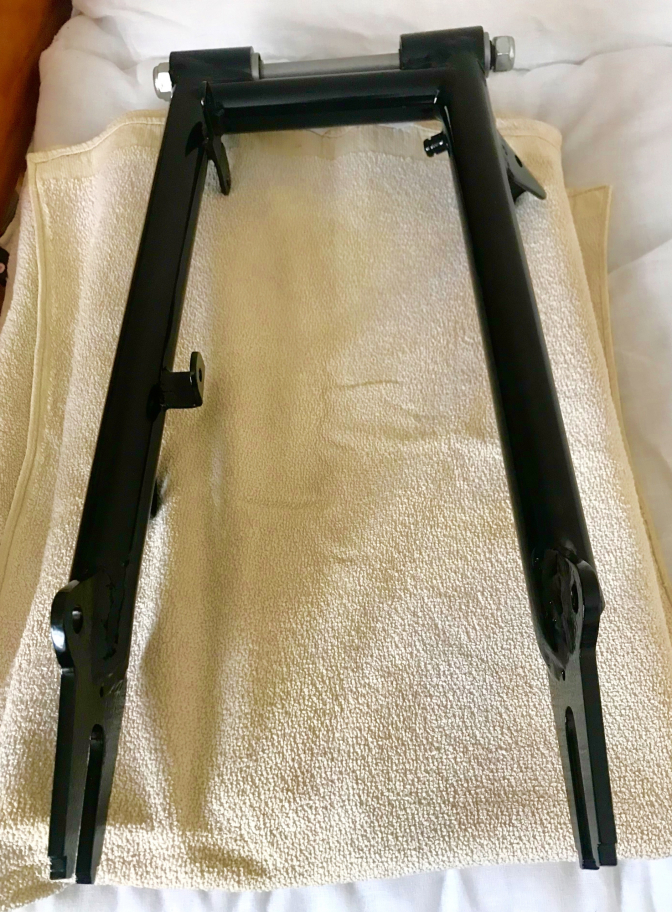
New Foster Otter Swinging arm...
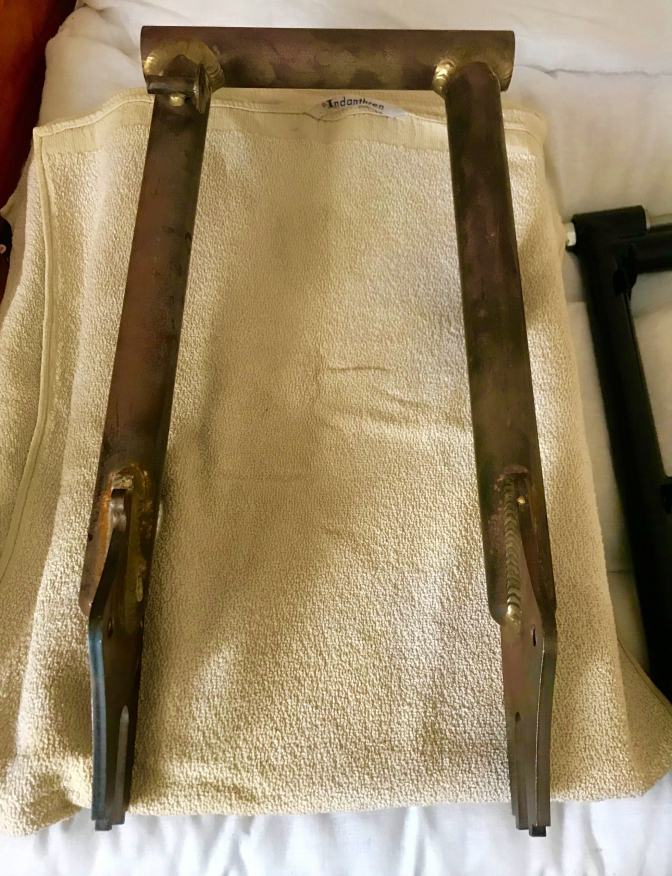
New Faber Mk3 Otter swinging-arm...
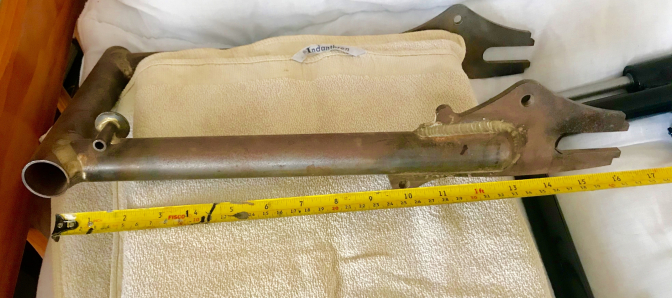
Faber S/A 15" centre's...
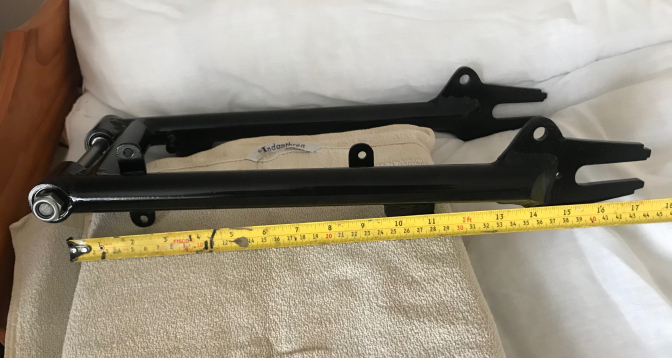
Foster Otter S/A 16" centre's...
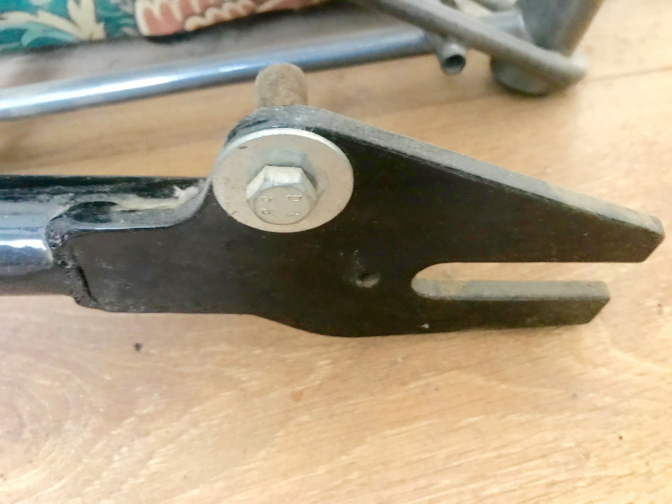
My laser cut wheel plates, as used on most of the bikes I have built, bar for the Mini-Otters. and Foster Otters
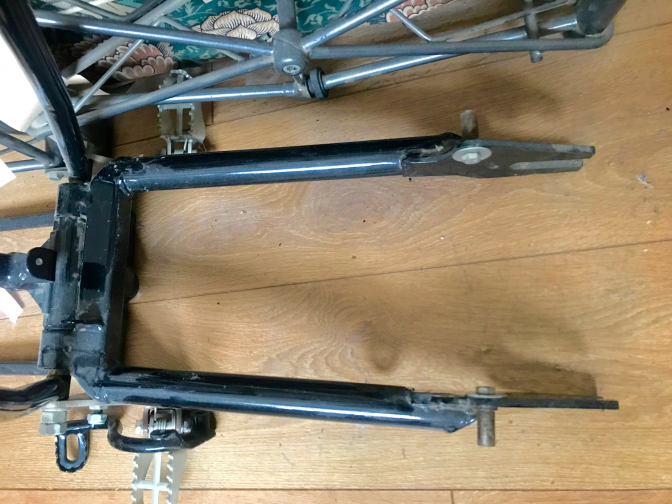
The Bantam swinging arm, sorry about the dust...
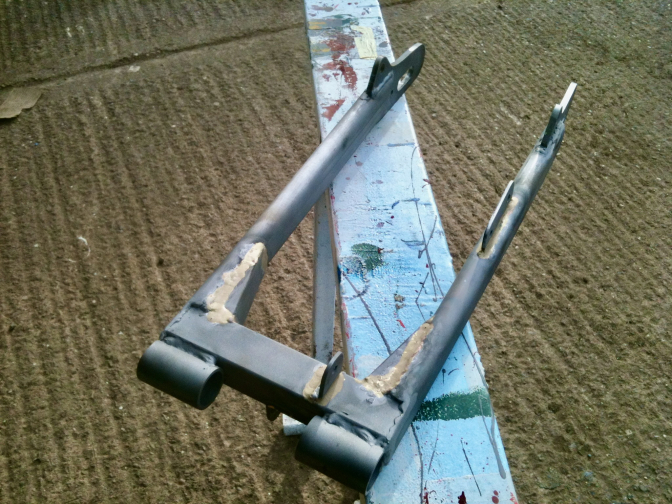
This is the replacement swinging arm I built for Mini-Otter Number One as Brian wanted to see if it made any differance to the handling and traction of the bike.
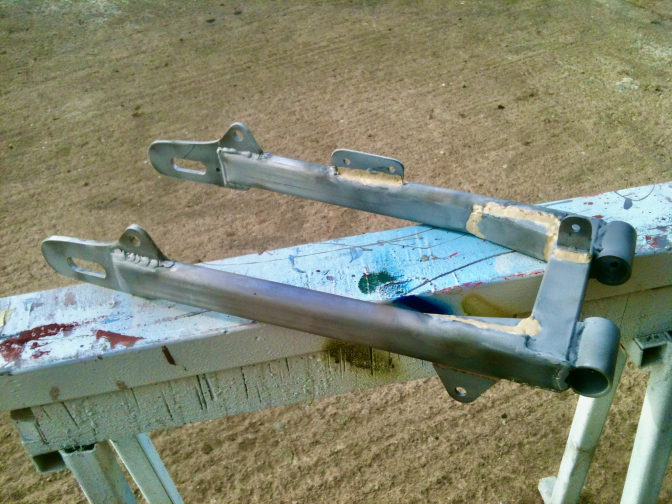
You can see a change of construction with this arm to what I usually do bronze weld the lot, but on the 6mm wheel plates and the same thickness for the pivot tubes I used the mig welder on these joints mainly because of speeding up the job as there was a time problem, and bronze welding thick steel takes a lot more heat and time, but although going back on the next Mini-Otter arms with the same pattern as this arm to bronze weld the lot. Any more I have to do would be as for this arm, as Brian has used it for three years without a problem, so it is sense to speed the build time up using this "Two weld" method...
If you read above you will know that we both thought this arm made a difference...
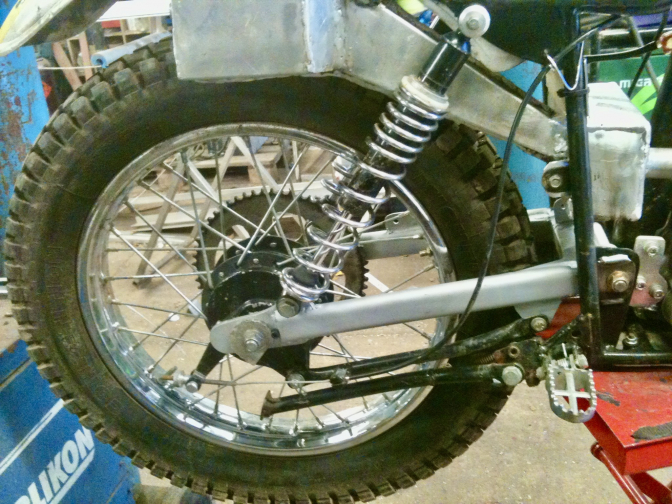
New arm made and fitted in a day...
25/05/2023...
I have just finished Mini-Otter swinging arm number eight... this is a replacment arm for number five that was lost at the powder coaters, but I think this new arm the best I have made for this Mini-Otter range of trials bikes...
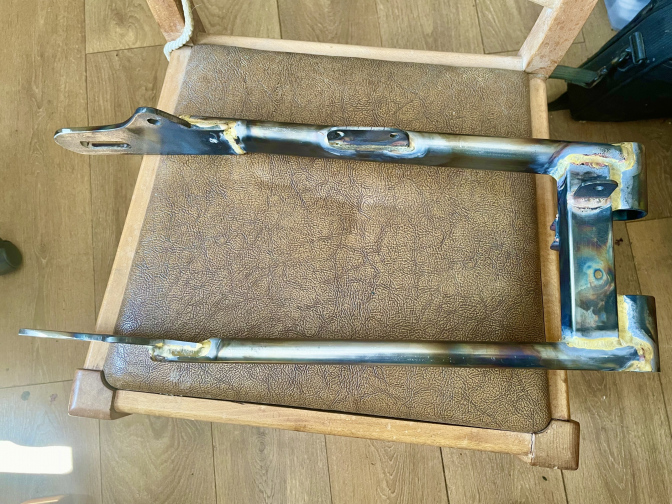
Now fully bronze welded again and top quality oval tubing used...
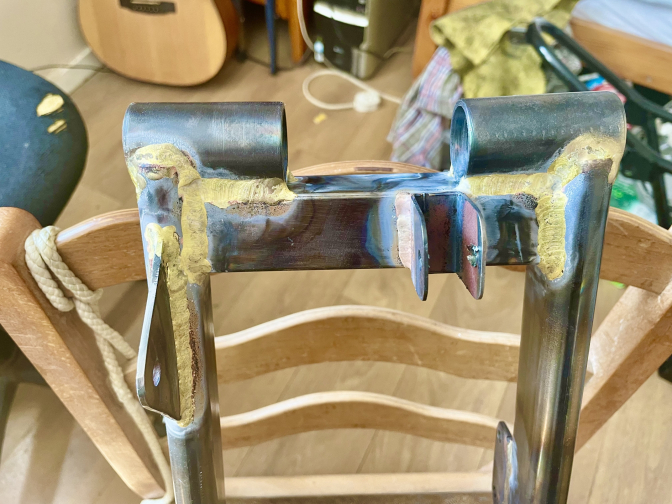
All Photo's Courtesy "Otterman"...
Now again using silent block bushes of a lager diameter...
Stay Safe……..
More later this only a start… Loads of photo's later to better explain…
More Swinging-Arms later, I need the exersize ....page started during Lockdown One... and added too in Lockdown two and three..
We will later look into trials frames used on British trials bikes up until the late sixties...
Updat2024...08...





